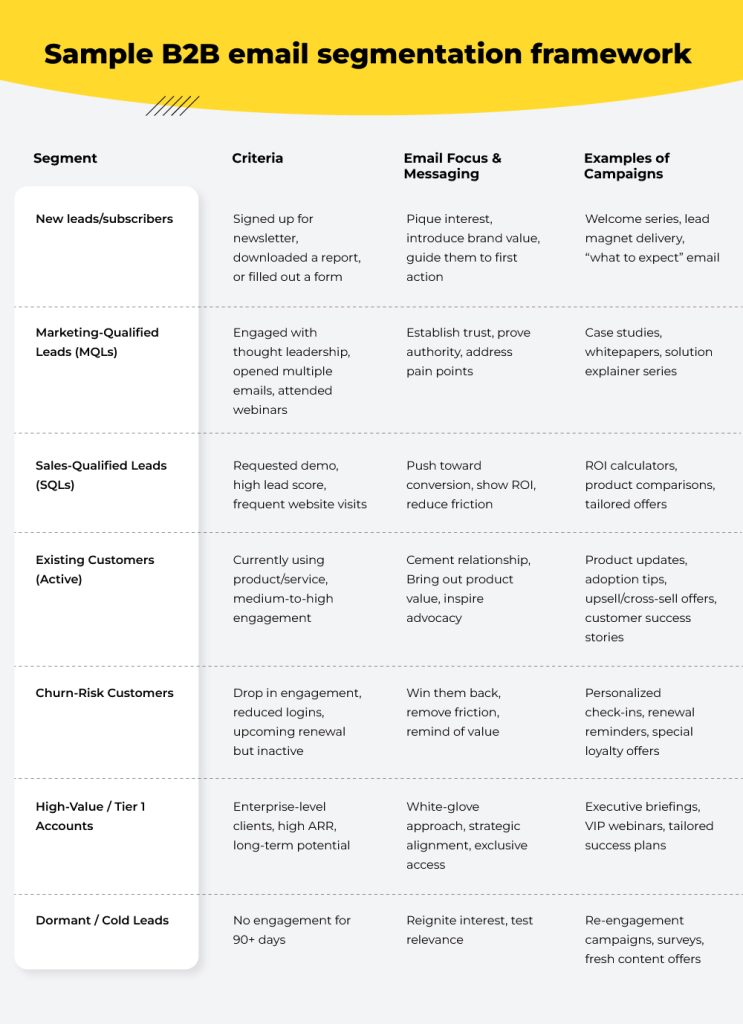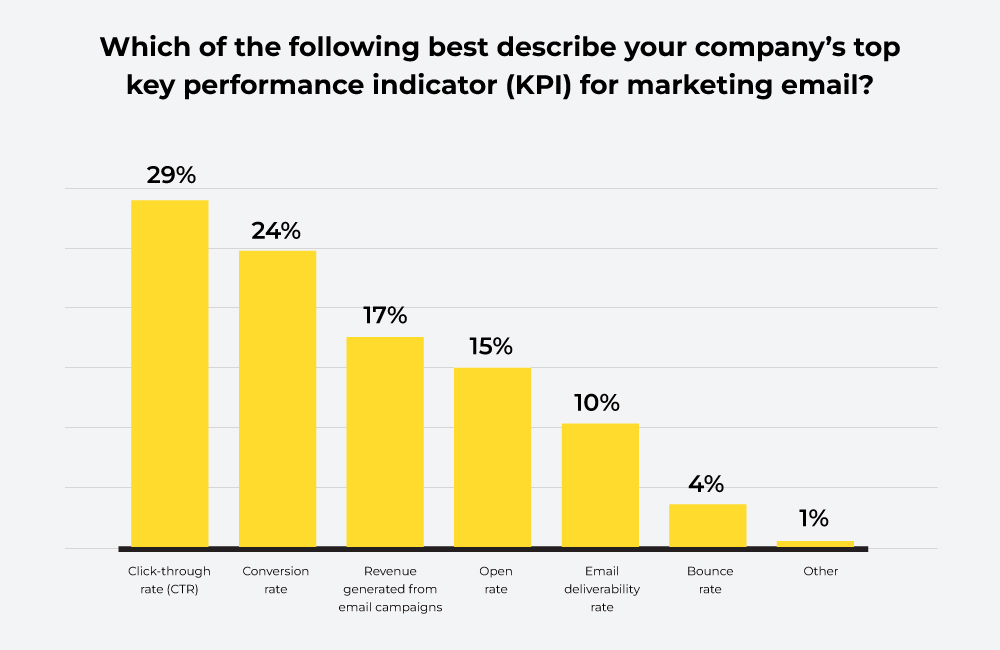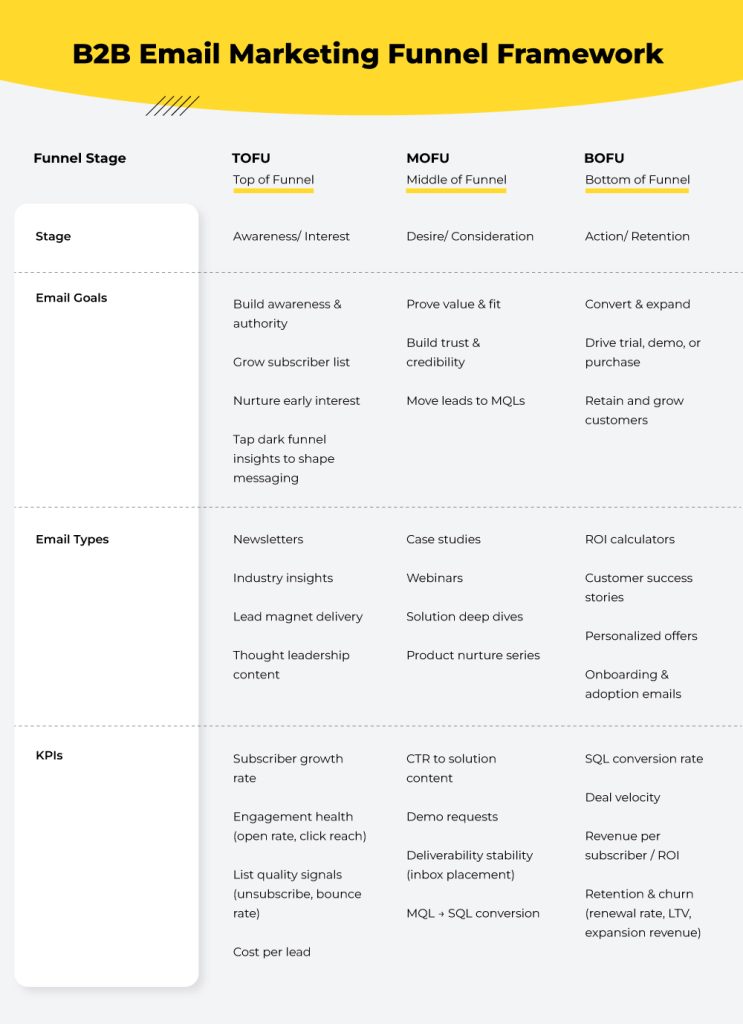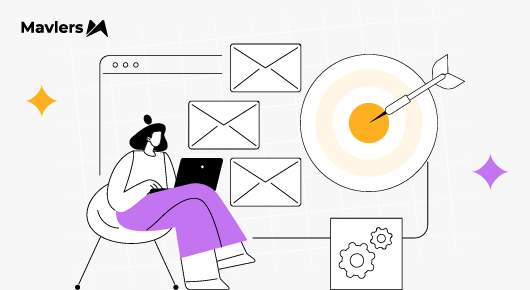CMSwire says marketing budgets are shrinking, but CMOs are still supposed to pull rabbits out of hats.
Translation: do more with less, and smile while you’re at it.
And guess who’s caught in the crossfire? Email marketers.
One day, we’re the hero (“Hey, revenue’s dipping, send another campaign!”). The next, we’re invisible when the budget pie gets sliced.
No wonder so many teams are stuck in the hamster wheel of request → production → send. Meanwhile, money bleeds into platforms, data, and pretty templates.
Truth? “We send an email every Tuesday” is not a B2B email strategy. It’s a calendar reminder. Neither is chasing open rates while the CFO side-eyes you for pipeline impact.
That much-revered $36 ROI? Without a well-planned strategy, it’s just a myth — not a metric. It’s only when you couple clear phases, goals, and KPIs to the funnel, it becomes a reality. Else, you waste money on the emails that fail to justify that budget.
When funnel-based planning teams up with campaign objectives and holistic testing, you get what every budget-conscious marketer wants: a smarter, not pricier B2B email strategy.
So let’s show you how a ROI-boosting B2B email strategy is built—from someone who’s been at this for over a decade and a half. Shall we?
Essential steps of a B2B email marketing strategy that ensure you don’t waste budget
The B2B conversion process doesn’t have to drag on forever. With the right B2B email funnel, buyers move faster, and you stop bleeding budget.
So what’s a B2B email marketing strategy, really?
A true B2B email strategy goes beyond “who gets what and when.” It aligns email with business objectives, maps campaigns to the buyer journey, defines success metrics, and establishes a framework for testing and continuous improvement.
In short, it’s not just about sending emails — it’s about building a revenue-driving program. Not a random list of “B2B email best practices” or a list of unconnected tactics.
If you want emails that prove their B2B email marketing ROI, you need that framework.

Step 1: Deep segmentation
Sharp segmentation is the foundation of a performance-driven B2B email strategy. It’s also the most effective form of personalization available. Different prospects and customers have different relationships with your brand — segmentation ensures your campaigns reflect that instead of treating everyone the same.
To create a segmented email list:
- Gather data. Not just from your CRM. We want the smart, more holistic kind. Such as firmographics (industry, size, location, tech stack), behavioral data (downloads, clicks, site visits), and psychographics (pain points, goals) are all gold for nailing a data-driven B2B email strategy.
- Tier the accounts. Every account doesn’t need to have the same slice of your time or resources. Rank them by the potential ROI.
- Segment by lifecycle. Early awareness, active consideration, onboarded users, and expansion targets. Each gets its own narrative arc, cadence, and call-to-action.
- Sync segmentation with lead scores. That way, you know how ready the leads are. And plan faster nurture sequences for high-intent leads and slower drips for tire kickers.
Know that segmentation is also going to be your north star that guides you on how to set up and automate nurture workflows.
Step 2: Set B2B email campaign objectives
Most B2B email marketing strategies fail when they start with “what email should we send?” in place of “what business outcome are we driving?”
Not every email campaign should scream “Buy now.” Sometimes the job is to educate, build trust, or retain existing customers.
As Cynthia Price, SVP of Marketing at Validity, puts it:
“Strategy is about what you’re trying to help your audience do within a specific timeframe. The end goal doesn’t always have to be numbers. It’s about creating a positive change with your audience.”
The right objectives strike a balance between your business priorities and the audience segment you’re targeting.
In any case, the goals should be S.M.A.R.T.: specific, measurable, achievable, relevant, and time-bound. An example could be, Convert 20% of webinar leads into MQLs within 30 days.
Most B2B email marketers are gunning to :
- Increase sales and revenue.
- Grow pipeline by nurturing leads into MQLs.
- Better retention by aiding the adoption of a new feature.
- Re-engage a stale segment before they churn.
Any campaign you send should clearly ladder up to one (or two) of these.
For a new contact, someone who signed up for a newsletter or downloaded a report, your email’s job is to fuel their interest and guide them to the next step.
For nurtured leads? They know you well. So, now it’s about layering trust. Whitepapers, case studies, and webinars that show authority work their charm here.
On the other hand, product updates, in-depth resources, and personalized check-ins from your email campaigns help keep existing customers with you.
Here’s a sample segmentation framework for B2B email marketing strategy—

Step 3: Stage email campaigns
Now that you’ve split your email list into segments, the question pops up: what kinds of emails does each group actually need? That’s where staging is required.
Here you map your B2B email campaigns to the exact steps your buyers take. Mapping lets you zoom out and see the big picture: who you’re targeting, what stage they’re in, and what emails will ease them forward.
Tools like Miro, Figma, or Lucidchart are your caped superhero here for plotting the stages.
Important>> you must’ve noticed this—some platforms emphasize the customer journey, others the funnel — as if you have to choose one.
So let’s clear it up for you.
Whether you call it the customer journey or the marketing funnel, they’re not competing frameworks. They complement one another.
- The customer journey is the full experience a customer has with your brand. A map of actual buyer behaviors, touchpoints, and non-linear progression.
- Awareness → Interest → Desire → Action → Retention
- The funnel breaks down the buyer’s path into neat stages: TOFU, MOFU, and BOFU.
The best B2B email strategies marry these two. Put them together and you get a blended framework—the modern B2B buyer journey funnel that—There’s one more hidden layer to the story: the Dark Funnel.
This is where buyers research and influence each other off the radar of traditional tracking. On competitor sites, in private chats, social media groups, and third-party forums.
70% of their buyer’s journey (and decision-making!) happens here, invisible to most marketers.
And increasingly, much of that influence takes the form of zero-click marketing: buyers get what they need from snippets, summaries, and shared insights without ever clicking through to your site.
A strong B2B email strategy needs to recognise this shift, weaving Dark Funnel insights and zero-click behaviour into messaging that engages earlier and adds value faster.
Step 4: Develop automated nurture workflows
“Automation is how you take the human touch and multiply it across every stage of the buyer journey.” says Mavlers’ CRM strategist, Jeegyassa Tare.
Plus, automation lets teams focus on strategic decisions.
B2B brands with strong automated workflows can vouch for their value: they guide leads through the journey with timely, relevant touchpoints.
Whether it’s:
- Welcome and onboarding sequences that introduce new contacts to your brand.
- Lead nurturing workflows that deliver gated content, insights, and educational resources.
- Re-engagement campaigns that reconnect with inactive or dormant leads.
Our experience tells us that when these workflows are well-structured, brands have the most practical approach to move prospects faster. Without sacrificing quality or burning out your best minds.
Step 5: Define KPIs and measurement framework
How do you know if this whole B2B email marketing strategy is even working? Without the right measurement framework, your strategy is a stab in the dark.
Litmus notes most marketers currently obsess over bottom-funnel metrics—clicks, conversions, and revenue per email.

Yes, those matter. But as the email marketing expert, Chad White reminds us—
“The real job of email marketing is to get the next email read. Build engagement and trust first, and conversions will follow.”
So, what KPIs should you measure for B2B email campaign optimization?
Follow your business goals and rank KPIs accordingly.
For instance, if the email list is an issue, this is probably not the time to focus on “revenue per send”, unless you like to be disappointed. Instead, look at the vital signs of unsubscribe, bounce rates, and deliverability.
Nurturing prospects? Track engagement. See if prospects are opening and clicking.
Or is the goal retention? Measure—how long are people staying (LTV)? And are they leaving (churn)?
Here are the core KPI buckets to track:
- Engagement health: open rate, click-through rate, click reach
- Deliverability: bounce rate, inbox placement, unsubscribe rate
- Revenue impact: conversion rate, revenue per subscriber, ROI, LTV
Are external benchmarks useful in measuring campaign performance?
Yes, they can be. But don’t treat them as targets carved in stone. Chad suggests using them as guardrails-
- If you’re doubling industry averages on opens or clicks, great.
- If you’re below half, cause for action.
- For negative metrics, like bounces or unsubscribes, more than 2x the benchmark is risky.
What is more useful than comparing raw numbers, is looking at year-over-year and month-over-month changes against industry benchmarks.
If your open or click rates improve or decline in the same direction as external benchmarks, it often means you’re being affected by the same big-picture factors, such as market changes like Apple’s Mail Privacy Protection or inbox provider updates.
Campaign vs. relationship view
Measuring success one campaign at a time is tempting. That’s fine, but incomplete. Conversions from single campaigns may be low, given the long B2B sales cycles.
A better lens is subscriber-centric metrics:
- Distribution of subscriber tenure
- Churn rate
- % of subscribers engaging in the last 30/90 days
- Conversion flow from MQL to SQL
These tell you if email marketing for B2B companies is building durable relationships, or just getting hollow clicks from people killing time at their desks.
Here’s a template of a marketing funnel you can use as part of your B2B email strategy:
B2B Email Marketing Funnel Framework

Step 6: Holistic testing
Too often, B2B marketers test emails just to find a short-term winner—“Did version A or B pull more clicks?”
The real value lies in deep, long-term insights into what drives your audience across channels. That’s holistic testing —a methodology from Holistic Email Marketing.
One of the biggest advantages of basing your campaigns on Holistic Testing is that you spend less on ineffective campaigns and get better returns across your whole marketing program.
- Define objective
Set goals beyond immediate uplift. Ask:
- What motivates my audience—fear of loss or desire for gain?
- How can I increase average order values?
- How can I get more traffic efficiently?
Your test should reveal why something works, not just what works.
2. Hypothesis
Pick a specific pain point. For example: “What will make our trial users convert to paid faster?”
Put that into a clear testing plan and create a hypothesis:
“Loss-averse messages will convert better because people hate missing out more than they enjoy benefits.”
3. Select the factor(s) to test
This could be subject lines, CTA placement, or email cadence. Since Holistic Testing is hypothesis-led, you can sometimes test multiple factors while still getting clean, actionable insights.
4. Ensure valid results
Use the right sample size. B2B databases can be small, so run the tests as 50/50, which allows you to run the variants simultaneously to avoid time bias.
5. Analyze
Analyze the data. Confirm results are statistically significant. Record not only the winner but why it won—what you learned about customer behavior.
Step 7: Build feedback loops and continuous optimization
Objectives → Funnel phase → KPIs → Testing → Insights → Back to Objectives.
In B2B marketing—where buying cycles can drag on, closing the loop is what keeps your B2B email strategy from going stale. These feedback loops turn insights into action, and action into growth.
- Run a quarterly “lost deal review” survey. Survey lost leads to understand why they didn’t convert. To surface recurring objections. Feed the insights back into your strategy, your sales scripts, and even your product positioning.
- Have your customer success team tag FAQs in the CRM. Are they hearing anything that should show up in your nurture streams? So marketing can fold them into onboarding and retention emails.
- Add a win/loss analysis step to your nurture refresh process to keep messaging sharp and aligned with what the market is actually saying.
- Small improvements compound over time. Hypothesize. Test. Adjust. Repeat.
- Set-and-forget is a strategy for furniture, not email. A strategy needs ongoing review and refinement. So, review KPIs and share the results across teams.
That’s the engine that keeps your email program ROI-driven, not expense-driven.
TL;DR:
- Segmentation and automation shapes your B2B email marketing strategy.
- Every campaign needs a business outcome.
- Funnels give structure; journeys give context. Together, they keep your strategy buyer-led and relevant.
- The right KPIs show progress toward relationships, not just clicks.
- Holistic testing uncovers why buyers act, fueling smarter campaigns.
- Feedback loops keep your strategy adaptive, and ROI-positive.
The road ahead
Reading is good. Taking action is better. If you’re ready to move from strategy notes to a fully automated, cost-optimized B2B email engine, let’s talk.
Or, if you’d rather keep exploring, these blogs are the perfect next stop: Email Automation to Overhaul Your Campaigns: The Ultimate Guide
The Marketers Guide To Choosing The Best, Most Suited Email Marketing Automation Tools
Starting Email Marketing? Here’s How Mavlers Makes It Easy (and Effective)


Kath Pay - Reviewer
Kath, the Founder and CEO of Holistic Email Marketing, is a veteran in the email marketing industry. A renowned international keynote speaker and one of the UK’s leading email marketing tutors, she is widely recognized for her expertise and thought leadership in the field.
Urja Patel - Content Writer
Urja Patel is a content writer at Mavlers who's been writing content professionally for five years. She's an Aquarius with an analyzer's brain and a dreamer's heart. She has this quirky reflex for fixing formatting mid-draft. When she's not crafting content, she's trying to read a book while her son narrates his own action movie beside her.
The Modern B2B Buyer Has Changed. Has Your Email Strategy?
Scaling audience targeting & lead qualification with Marketo Smart Lists